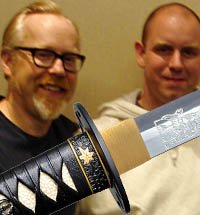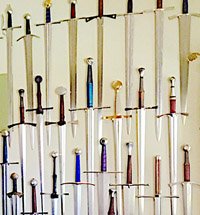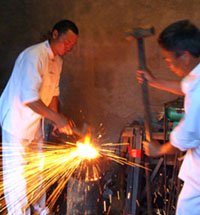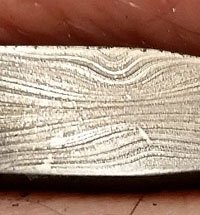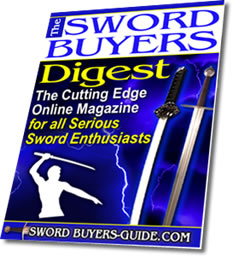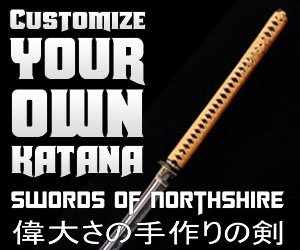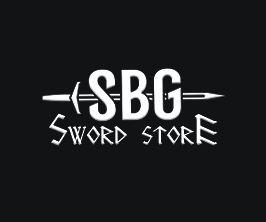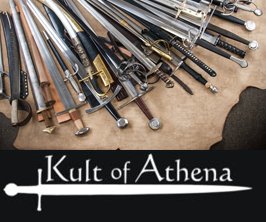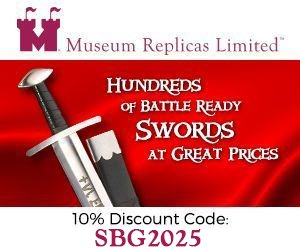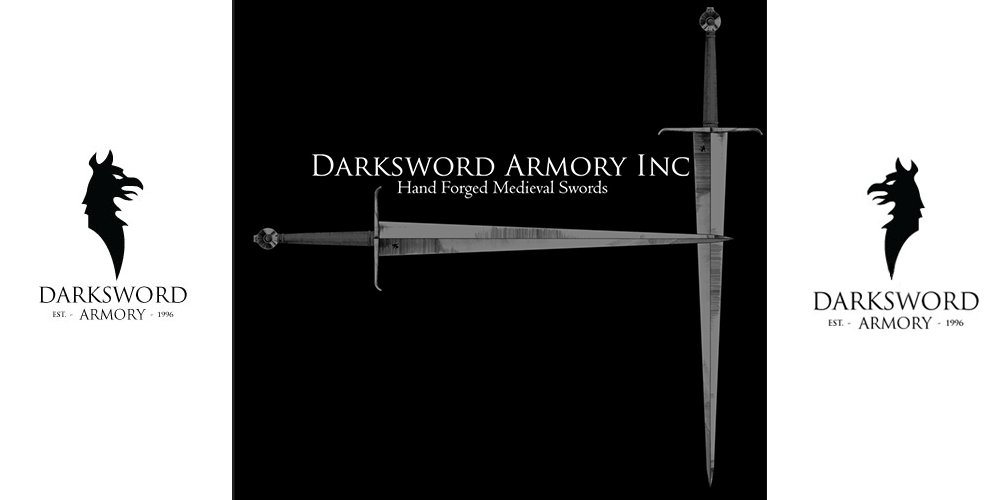Recent Articles
-
Real Katana Pushed to the limits
Mar 07, 25 01:16 AM
Battle Ready Vindaaris Review
In this comprehensive Vindaaris review, we delve into the craftsmanship, performance, and historical significance of the Vindaaris, a elf inspired 'medieval' sword from Darksword Armory, and explore whether it's worth the investment by examining its pros and cons.
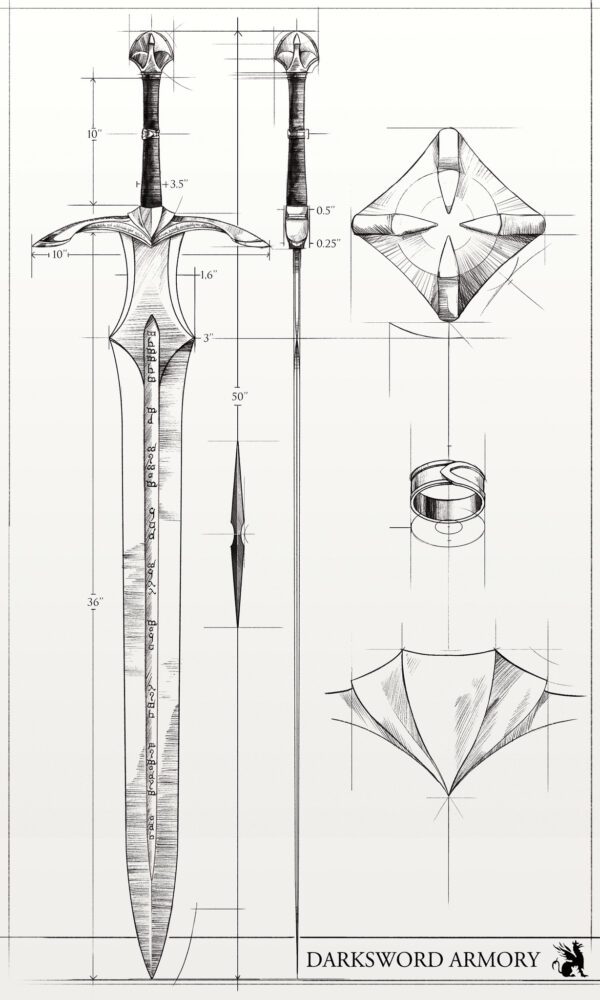 The original concept art sketch
The original concept art sketchThe Vindaaris Review
Review by Forum Member Kazarduin

I found this sword while looking around on Darksword Armory’s website. I don’t search out swords to buy, or treat myself all that often to a new sword. When I explore sword websites, it’s usually in search of design inspiration for my storytelling. That’s how I chanced across this sword. What caught my eye was the unique diamond-like flare in the blade, and the unique scabbard. I also love the color green, so the dark green hilt and scabbard helped endear it to me. And since my ideal sword archetype is Anduril from Lord of the Rings, I have a soft spot for swords with elvish runes engraved on them.
After staring at this sword for several months, I decided to go ahead and buy it. I ordered this sword directly from Darksword Armory, complete with the scabbard, sword belt, and sharpening service. I bought it alongside a fellow sword, Darksword Armory’s Mother of Dragons. I placed my order on May 31st, and it took about 3 weeks to ship. The Vindaaris shipped on June 21st to the U.S., and arrived on June 27th.
Sword Lore (Story Oveview)
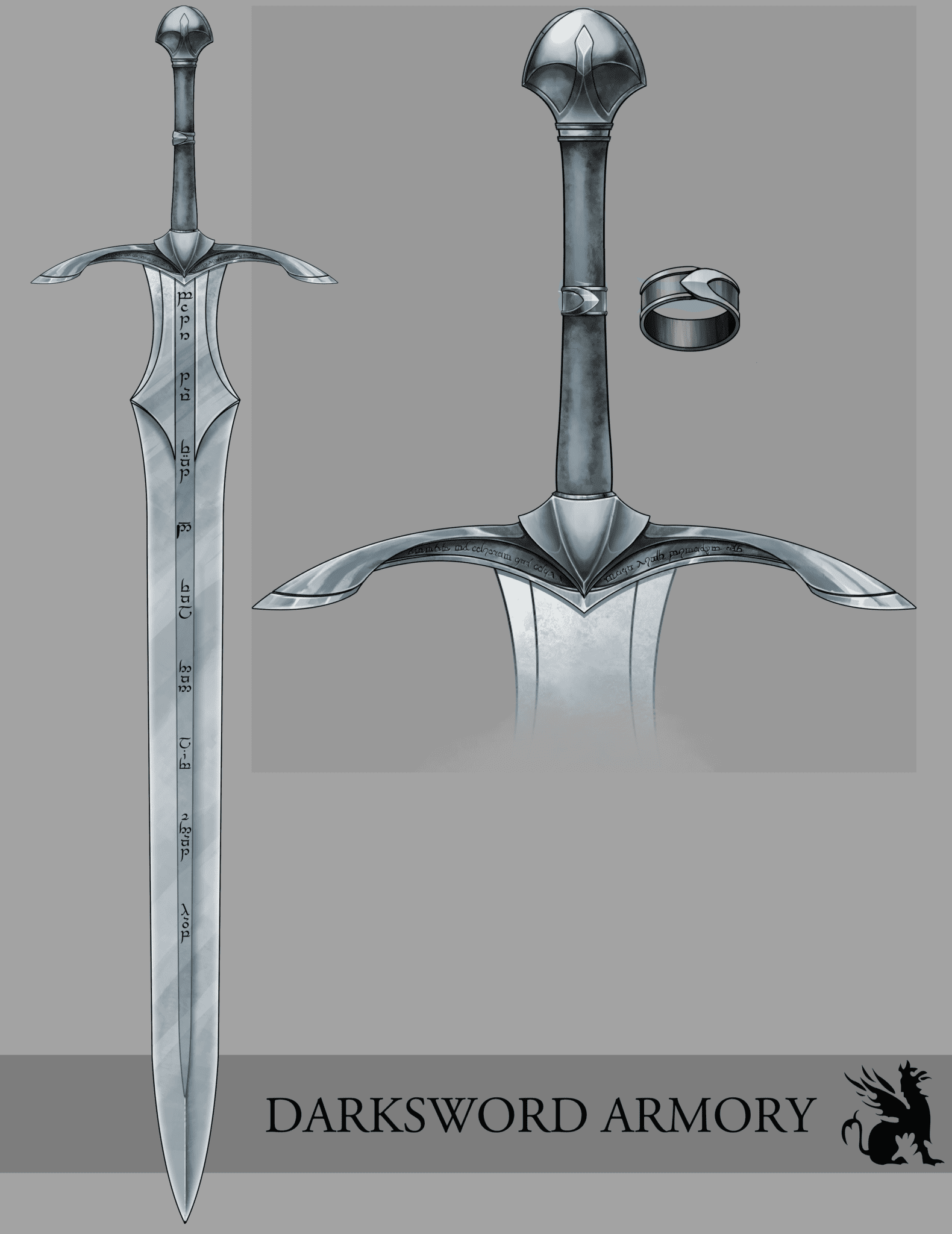
According to the website, Darksword Armory’s sword designer, Terry Maranda, drew from two sources of inspiration to create this sword. The first source is Norse mythology, and the second is J.R.R. Tolkien’s Lord of the Rings.
The Norse influence on this sword comes from the light elves of Alfheim, who pledged to aid Odin and the Aesir (Norse gods) in the great battle of Ragnarök. I don’t know if this was intentional or not (Darksword doesn’t say), but the very name Vindaaris also pays tribute to the Norse legend of Ragnarök. My sister, who loves Norse mythology, pointed out that “Vindar” is a variant of the name Vidar, the name of a more obscure god in the Norse pantheon. Like Thor and Baldur, he is a son of Odin, albeit one who stays in the background and almost never partakes in adventures. But he plays a special role in Ragnarök: it is said that when Fenris slays Odin in the great battle, Vidar will avenge his father by ripping Fenris apart with his bare hands (Yikes!). Because of his prophesized role in Ragnarök, one of Vidar’s portrayals in Norse mythology is a god of vengeance, which in turn makes the name Vindaaris synonymous with vengeance. The Sword of Vengeance, if you will.
The other inspiration, as previously stated, comes from Tolkien’s Lord of the Rings. This influence appears to manifest in two particular aspects of the sword: in the curved guard, which is reminiscent of Glamdring, and the runes that decorate the blade, crossguard, and scabbard, reminiscent of Anduril. There was a limited edition run of 50 swords that bore a special Tengwar script, but from what I see the normal Vindaaris also bears Tengwar script. They appear to say the same thing: “Better to fight and fall than live without hope.” The only difference that I can identify (from pictures, mind you) is that the limited edition Tengwar is a different dialect or style of the writing, whereas the normal version is the standard dialect/style found in the appendices in the Return of the King.
Full Disclosure
Below are several biases that may or may not affect my Vindaaris review and opinions about this sword.
1. I am a woman who stands at 5’ 5”. To some people this is not a big deal, but be aware that this means I am not as strong nor as tall as some sword enthusiasts. This will affect how I perceive the handling and abilities of this sword.
2. I do train with swords. I train and compete in sport fencing, so I spend most of my time with fencing blades, particularly epees. These swords are very, very light compared to a longsword. I also train a little in the Fiore Italian longsword style, and my weapon of choice is a Windlass Battlecry Agincourt sword. This is a sword that feels like it was made for me, and handles like it is an extension of my body. It is of an ideal length and weight for me to wield, so bear that in mind when I discuss handling. My standard of comparison is the Windlass Agincourt sword.
3. I do not require perfection out of my swords. I do look for cosmetic defects, but I tend to see the minor ones as unique features of my blades that set them apart from identical swords.
4. I don’t like to destroy my swords (and I lack the strength to do any serious damage to them) so as a rule I don’t do destructive tests (i.e. hitting solid wood or metal) or try to push my blades to the limit, and I physically cannot stand the sight of a flex test.
5. I paid full price for this sword, which cost $840.00 in U.S. dollars, plus shipping and tax. My review is completely voluntary, arising from my desire to contribute to contribute to the sword community by supplying information about my experience with this sword, and has not been solicited by any entity.
Unboxing & Initial Impressions
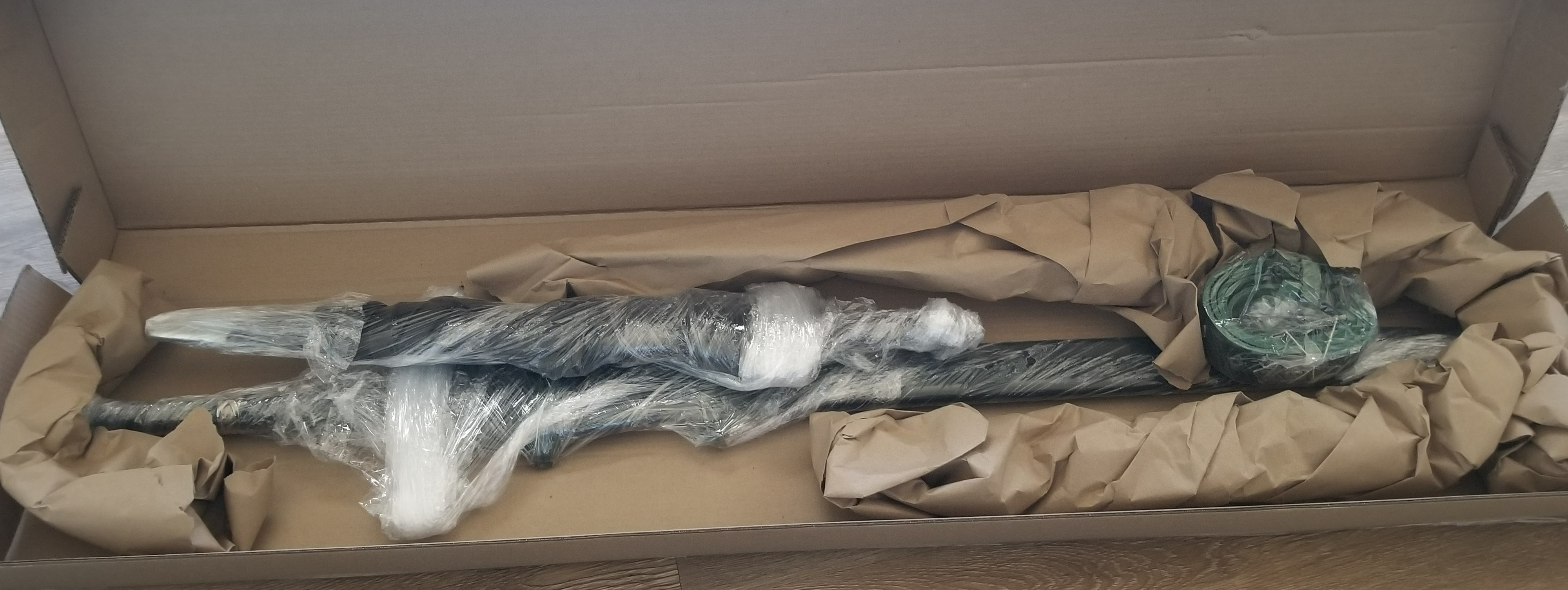
The sword arrived in a standard Darksword Armory shipping box. It didn’t rattle when I shook it, which indicated a good packing job. Upon opening the box, I discovered the Vindaaris and its fellow sword, the Mother of Dragons, obscured in shrink wrap and surrounded by brown packing paper.
The Vindaaris looked like Shelob had snared it in a nefarious web of plastic wrap or cellophane when I first pulled it out of the box. I’ve heard about how difficult the wrap is to remove, so I timed myself as I unraveled it. It took about 45 seconds before I had the sword free of its wrappings, which amounted to 19.5 ft of plastic wrap when spread out.
The sword arrived in its scabbard, rather than being packaged separately. The sword belt was packaged separately, coiled in a small plastic protective baggie. When I drew the sword, I found the blade covered in a thick coat of grease. The grease resisted my attempts to remove it with a microfiber rag, so I took a shortcut and stabbed the blade through a large cardboard box. That took the grease right off, and gave me a first look at how sharp this sword is. Once the grease came off, the bright mirror polish of the blade was revealed. It is so brightly polished that setting it on the seat of a bar stool was enough to mar it. I kept having to clean it off with a polishing rag for cars to keep the metal mirror bright.
The first thing my eyes went to on the sword was the fine script work on the crossguard. It has a depth and crispness to it that I’ve never seen in an engraving before, and it is unrivaled by any jewelry, sword blade (including its own), or other ornament. Beautiful.
The curved crossguard and delicate arches that compose it reminded me of a bird’s wings spread in flight when held tip down. The detail on this sword is exquisite, particularly on the guard and scabbard. It compares to that of Glamdring and Orcrist from the Lord of the Rings films, and would not look out of place beside them.
Just holding it in one hand, it felt heavy. I had to be very careful about swinging it, since the weight is at least double what I’m accustomed to with the Agincourt. But there’s a sense of coiled power behind this sword, and I have faith it will be a good cutting blade. I just need to get used to the weight.
I opted to have the sword sharpened by Darksword, and it arrived paper-shearing sharp (not cutting sharp). The cut is not perfectly clean, but it still cuts with little effort.
Curiously enough, my Vindaaris sword lacked the usual Darksword Armory logo on its blade. This strikes me as odd, since every Darksword blade I’ve seen in pictures bears the logo, but I know it was forged by Darksword since I ordered directly from them.
The leather on the scabbard and belt was very coarse and dry. It’s hard to tell at this stage if the leather is just that way all the time, or if the journey from Canada to the U.S. dried it out. I used Saddlesoap on both to clean them up and help the leather, and that improved them somewhat. I will suspend judgement for the time being, because the shipping box spent the weekend in Denver, Co., during a hot spell with low humidity, and that can wreak havoc on leather no matter how hard you try to protect it.
STATISTICS
|
|
The Blade

The blade of the Vindaaris is made of 5160 spring steel, Darksword’s choice of steel for swords. It comes polished to a mirror bright sheen.
This blade is fairly unique in shape, with the wide, diamond-like flare about 5 inches off the guard. From the tip of the guard to the end of this flared diamond, the blade is mostly flat. Towards the edges, the blade gracefully slopes from the flattened flare to the cutting edges, giving it a very refined look. The transition is smooth and appears elegant, so that this unconventional feature of the blade does not appear gaudy or contrived. The fuller runs all the way to about 6.5 inches from the tip, and has a swooping oval shape, as though someone made the fuller by using an ice cream scoop to remove the excess metal.
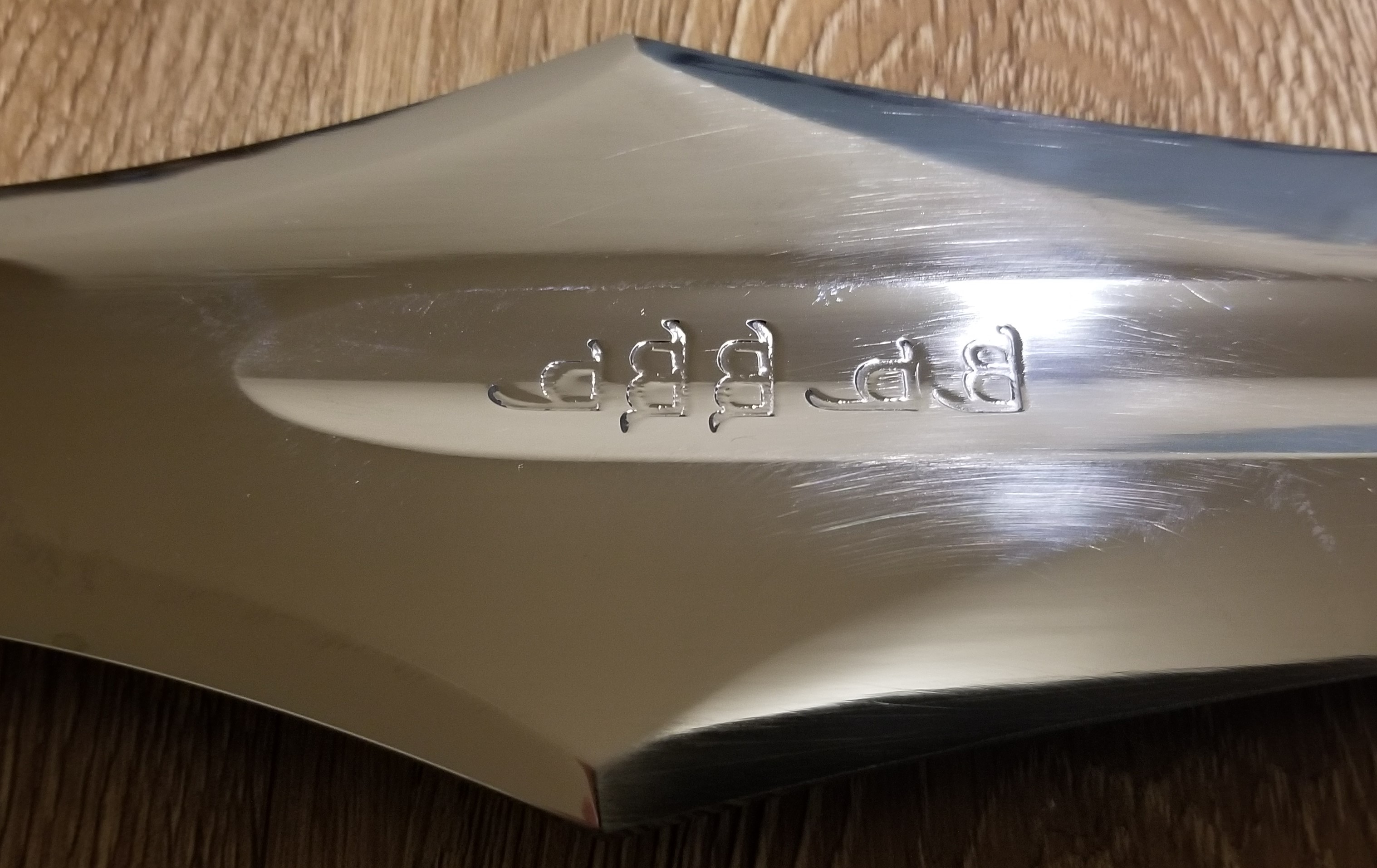
A word on this flare: many people might find this unattractive or overdone for a fantasy sword. I personally like it, as it gives the sword something very unique in the blade. If you’re a Dungeons & Dragons fan and play the 5th edition, this flare might look very familiar: in the 5th edition Dungeon Master’s Guide, pg. 175, the Holy Avenger sword drawing bears a very similar diamond-shaped flare that transitions into the sharp blade, complete with the thinner ricasso “neck” between the guard and the flare. With this in mind, I amend my earlier comment on this being the sword of vengeance; the Vindaaris would be the perfect holy sword for a paladin of vengeance in D&D, preferably one who worships the Norse god Vidar.
The runes on the blade are cleanly and clearly engraved in the fuller. It is obvious that someone took painstaking detail in their creation. It is easy to imagine the runes were written on the blade with a fine elven calligraphy quill. If the sword is set at the right angle to a yellow, orange, or red light, the runes glitter and glow as if their edges burned with tongues of fire. It’s a really neat visual effect, but hard to capture on camera.
The sharpening of this blade is rather interesting, given the unique design of the blade. The entirety of the edges from the tip to the base of the flared diamond section (about where the first set of runes ends) is sharpened. The diamond section and the narrow ricasso of the blade leading to the guard are left blunt. If I wanted to, I could overgrip the sword at this narrow point and flip it around to use as a lethal spear. That diamond-shaped flare in the blade stops the hand from running onto the sharpened portion when it is used this way. So the diamond-shaped flare is not just pretty and suitable for a fantasy theme, but it also serves a very functional purpose.
I paid for the sharpening service, and the blade arrived paper-shearing sharp, but not paper cutting sharp. The bevel where it was sharpened is barely visible, and nigh impossible to catch on camera. I had to be very careful trying to find where its sharpened edge started, using the flat of my fingernail as a guide, because it’s that difficult to locate by sight. See more information on the blade’s sharpness in the Test Cutting section below.
A major complaint about this blade is the condition of the tip: the last part of the tip was bent at an angle. I didn’t notice this defect until I showed the sword to a friend and fellow sword enthusiast (I’ll call him Mitch), who spotted the bend, so I’m not sure if it arrived this way or picked up the defect when going into the scabbard or thrusting at a cardboard box. Whichever the source, it raises concerns about the integrity of this particular blade, even after being carefully straightened by a bladesmith. Tips aren’t supposed to bend like in the picture below.
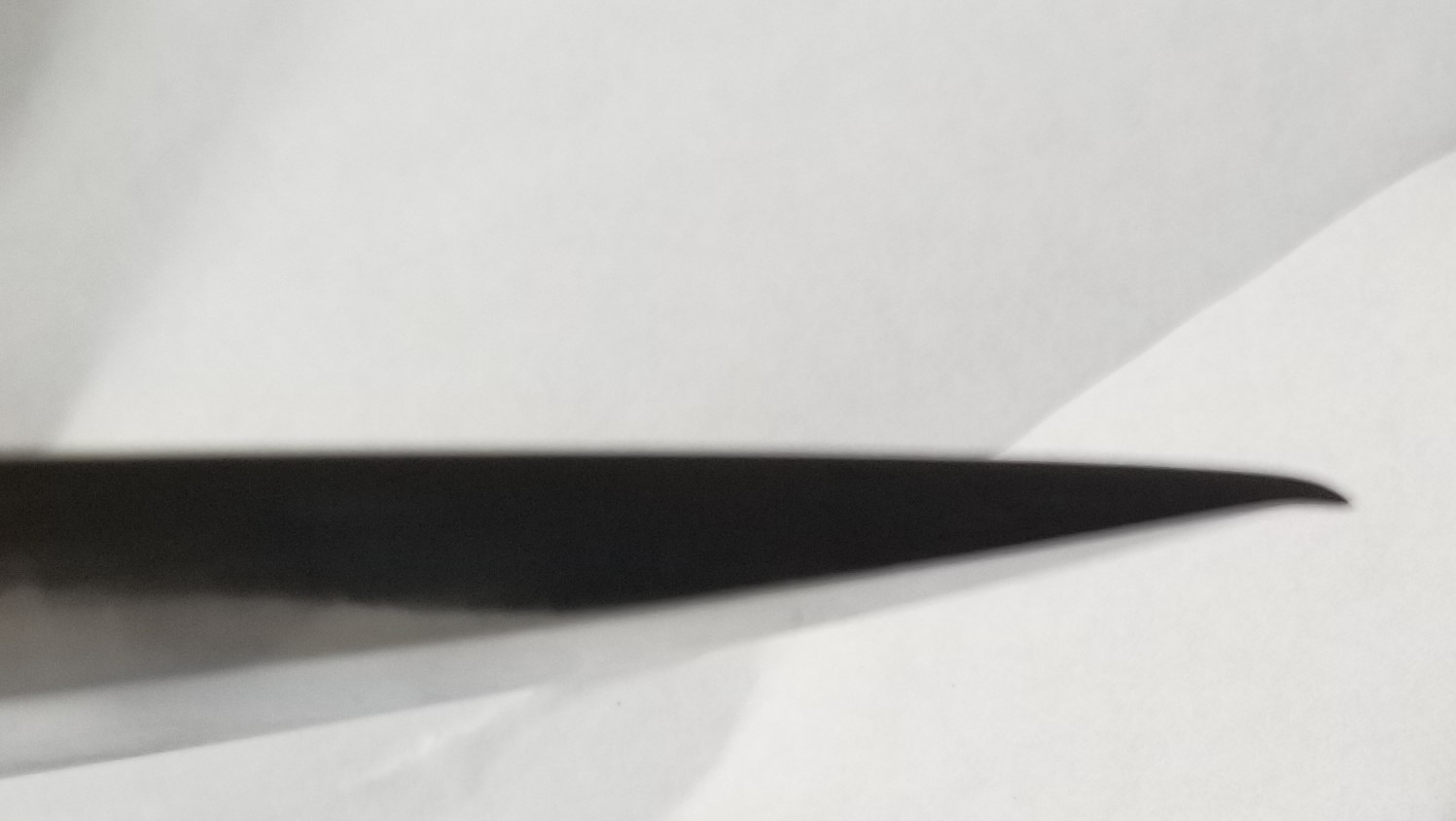
At some undetermined time after I had the tip straightened, it bent again. I can’t say what provoked the bend the second time, since I only used it on melons and water bottles since the repair. However, I did return the sword to Darksword Armory, and they straightened the tip out for me – their repair is holding up well. (See Customer Service section below for more)
The Guard

The guard is a little on the thicker side for a sword, width and depth-wise. I find it difficult to wrap a finger around the guard for extra point control while thrusting due to the thickness. When compared to the rest of the hilt components, it strikes me as disproportionately thick.
The very ends of the quillions are flat enough to press the thumb against, but then taper as they get closer to the center of the guard. As large as the tips of the quillions are, they alone would make a formidable weapon against an opponent too close to swing the blade at. The tapered oval shape will do a lot of damage to an opponent, and the guard has enough mass to deliver some very, very nasty blunt force trauma if used in a murder-stroke against an armored opponent, or jabbed into an opponent when there’s no room to swing or thrust the blade. If it were to strike an unarmored opponent, I have little doubt these quillions would pierce through skin. I tried the murder-stroke on a cardboard box, and the quillions punched straight through, got stuck in the cardboard, and caused even more damage coming out. Ouch!
The runes in the guard are all painstakingly carved, like those on the blade, except looking at the fine sweeping letters on the guard summons up images of the calligraphy on the One Ring. It looks very elegant, and even a touch dangerous, as if this noble sword has some sort of evil lurking deep within its metal. A good theme for a hero’s sword of vengeance.
The fit
between the guard and the blade is very good. There is the slightest of
gaps between the two, but it is filled with some black material, likely
epoxy.
My biggest critique of the guard is that its shape where it meets the pommel creates hot spots on the dominant hand during handling. When being swung, it digs into the thumb and forefinger, and feels very uncomfortable. To avoid creating pressure points, the sword has to be gripped an inch or so lower than normal, which affects the handling to the degree where it doesn’t feel particularly easy to control. This sword needs to be gripped as close to the guard as possible to control, but doing so creates a painful pressure point. It’s not the best design in that respect. Padded gloves help some, but it’s still uncomfortable.
The Handle

The handle is dark green leather with a cord impression. It is a bit bigger and thicker than I am accustomed to, and requires me to adjust my usual grip to accommodate the thickness and size. It is very, very long; I can easily fit four hands on the handle between the pommel and guard. I can fit two hands on just the grip between the guard and the decorative steel ring, and two hands between the steel ring and pommel without any problems. The upper part of the grip is shaped so that it will fit the dominant hand, which helps with grip and control. The bottom part, however, is round, which actually helps with practicing sword cuts, as the shape allows the off-hand the freedom to adjust.
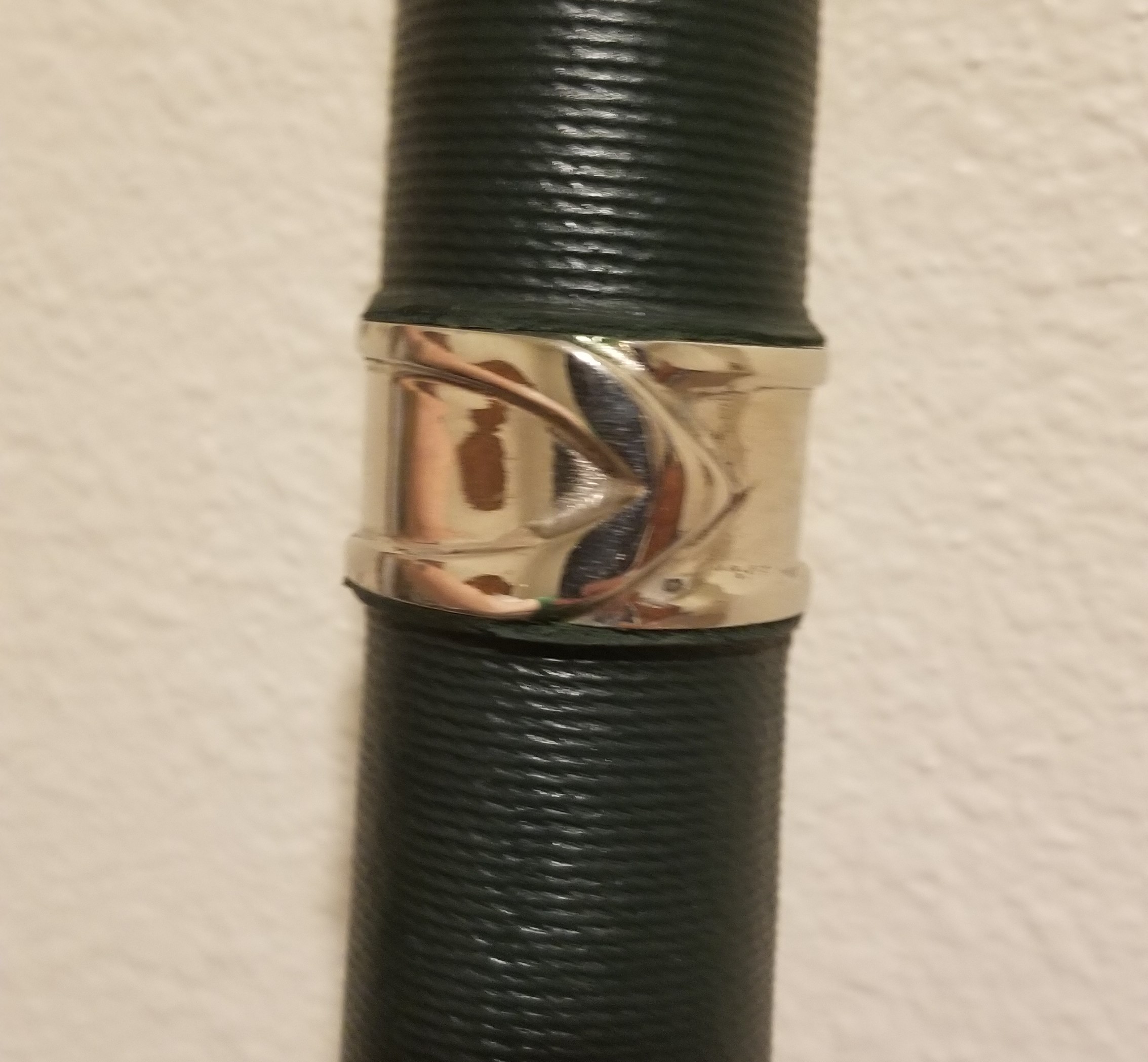
The decorative steel ring dividing the grip is about an inch wide, and decorated on one side with an interesting design that seems to mimic the end of the sword’s unique leather belt. The ring rises up a decent amount above the leather, which has the potential to catch on skin or gloves, and create a hot spot in the hand. It also appears to have been laid over the leather of the grip in such a way that it wiggles and twists in place. So far it hasn’t caused problems, and shows no signs of popping off its place on the handle, but alarms me whenever it shifts; I always worry that the handle itself has loosened before I realize that only the decorative ring moved.
One critique about the handle is the it doesn’t match the circumference of the pommel. I can run my thumb along the seam where the two meet, and feel the outer edges of the handle quite easily. This is more of a cosmetic issue than a functional issue, because it doesn’t affect the handling. But it does make the sword look rougher and a little cobbled together in appearance up by the pommel.
The Pommel
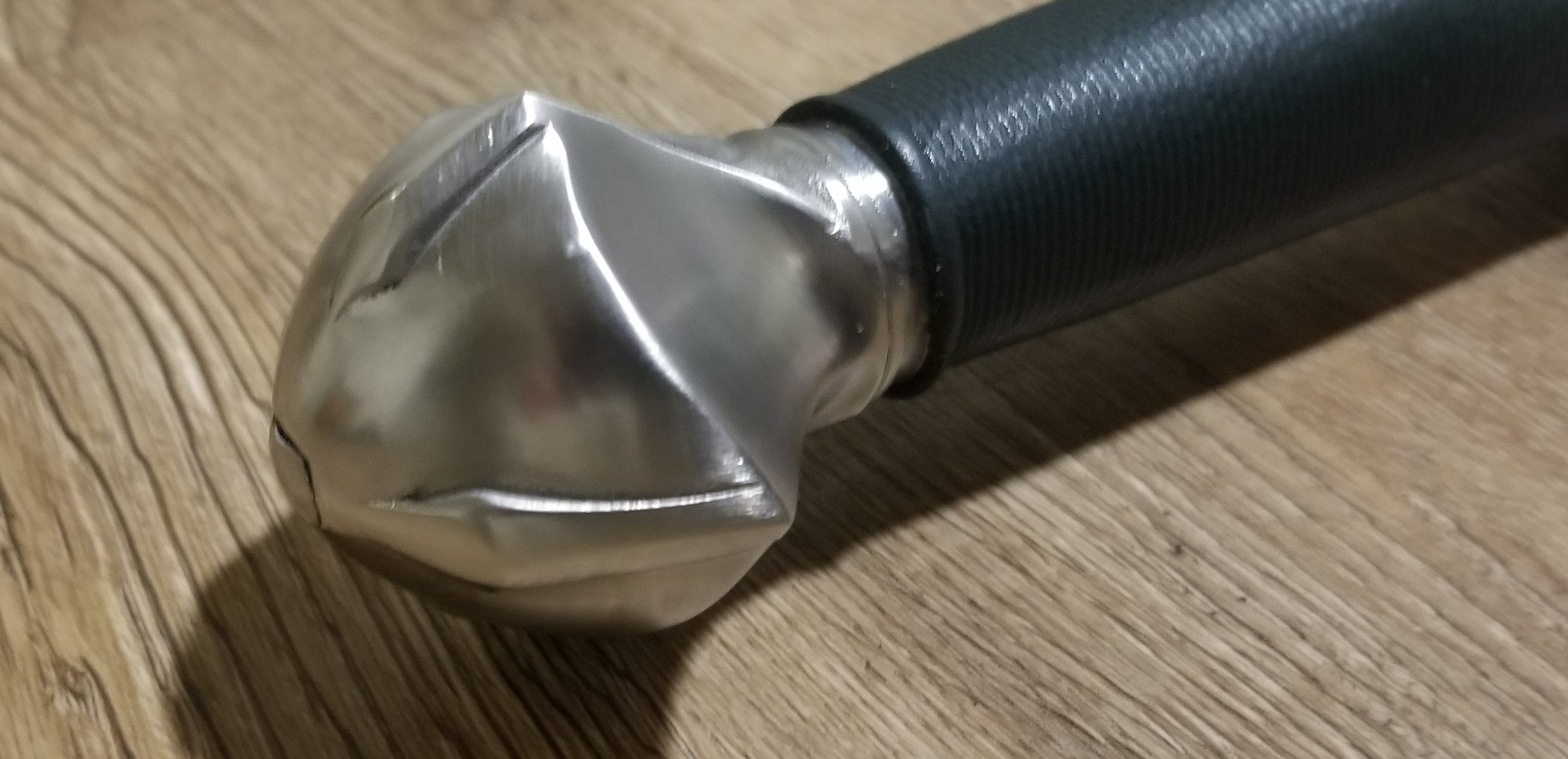
The steel pommel is a sturdy, functional, and
aesthetic piece. The top where the peen goes is smooth, and transitions
very nicely to the recesses close to the grip. The recessed part of the
pommel actually creates a very comfortable hand position. It feels like
it is molded for a hand to slide down flush against it. The ridges from
the claw-like design do not interfere with comfort when I hold the sword
this way. The claws themselves, which are designed so they appear to
hold the pommel in place, are very well done. When I look at the pommel,
sometimes I think that this design is more suited to Chrisopher
Paolini’s Inheritance Cycle than Norse Mythology or Lord of the Rings.
Eragon’s sword in the third book, Brisingr, is described as
having a pommel where ribs hold a large sapphire in place. The Vindaaris
sword’s claws only hold a steel pommel, not a gemstone, but every time I
look at this sword’s pommel, I think of Eragon’s sword.
The peen is very neat and lies flush to the pommel. It was clearly buffed afterwards, because the peen feels smooth, as if it were made as part of the pommel and not added on later.
Scabbard & Sword Belt


The scabbard is not Darksword Armory’s typical offer for their swords. Like all their scabbards, it has a wood core wrapped with leather (which is excellently stitched) and a metal chape, but the similarities end there. Rather than plain risers on the scabbard, this one is tooled with beautiful elvish designs, and the words engraved on the blade and guard are tooled down the length of the scabbard. This scabbard also lacks rain flaps typical on Darksword scabbards, and has a V-shaped cut out for the edge of the guard. The upper quarter or so of the scabbard widens above the rune inscription to accommodate the unique blade shape of this sword. It doesn’t look too bad really, although that extra space has to continue all the way to the top in order for the blade to fit, and leaves a lot of space for the narrow neck of the ricasso to wiggle around. I can shift the sword slightly from side to side near the top, but it barely moves at all.
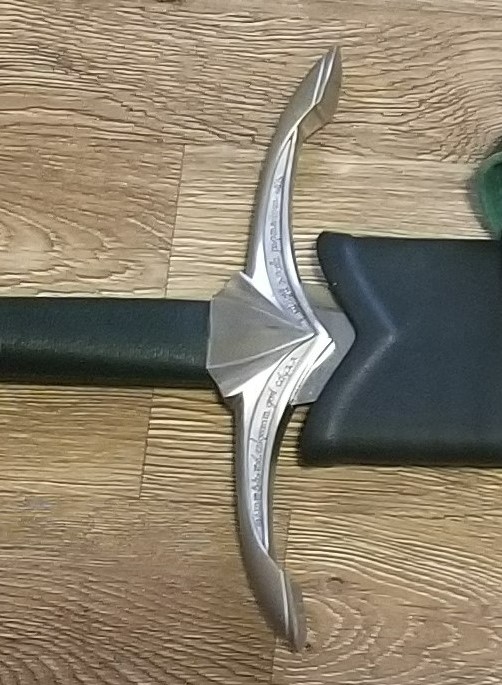
One of my two criticisms about the scabbard is the throat. The V-shaped cut out does not align well with the guard, and is large enough that the sword appears lopsided once inside it. This appears to be a standard flaw in this scabbard, as it appears even in the pictures on Darksword Armory’s website. Maybe they aren’t used to carving scabbards to fit the guards? I would assume so, since their usual design includes rain flaps not reinforced by wood. Otherwise the scabbard is very tight; I have to muscle the sword in and out of the scabbard, and it won’t fall out when turned upside down, even after several months of use.
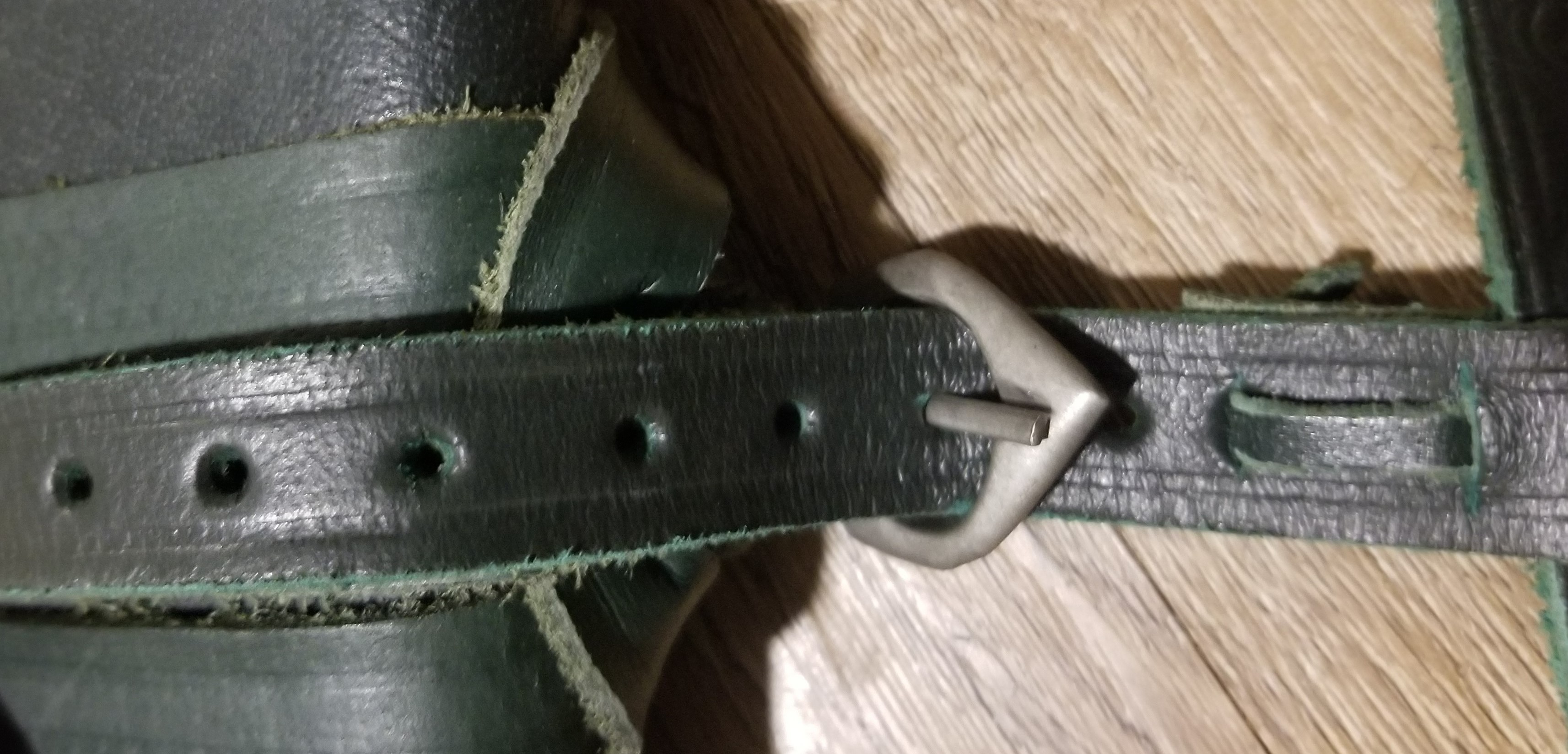
Unlike the usual interlaced sword belt, this scabbard only has leather wraps that hold small buckles in place. These then buckle to the intricately tooled sword belt, allowing them to be adjusted to the wielder’s height and carry preferences. My only criticism here is that the topmost leather wrap (seen above) has a tendency to come loose over time, and has to be retightened. It will also slowly work its way towards the throat of the scabbard, and I constantly have to readjust it to its proper position and tighten the straps back down again, sometimes multiple times in a single training session when I wear the scabbard. The fact that the leather has loosened over time with constant retightening also feeds into this problem. I don’t have the same issue with the lower wrap, though, since it is located where the scabbard narrows, and thus creates a natural barrier to the lower wrap moving up the scabbard.
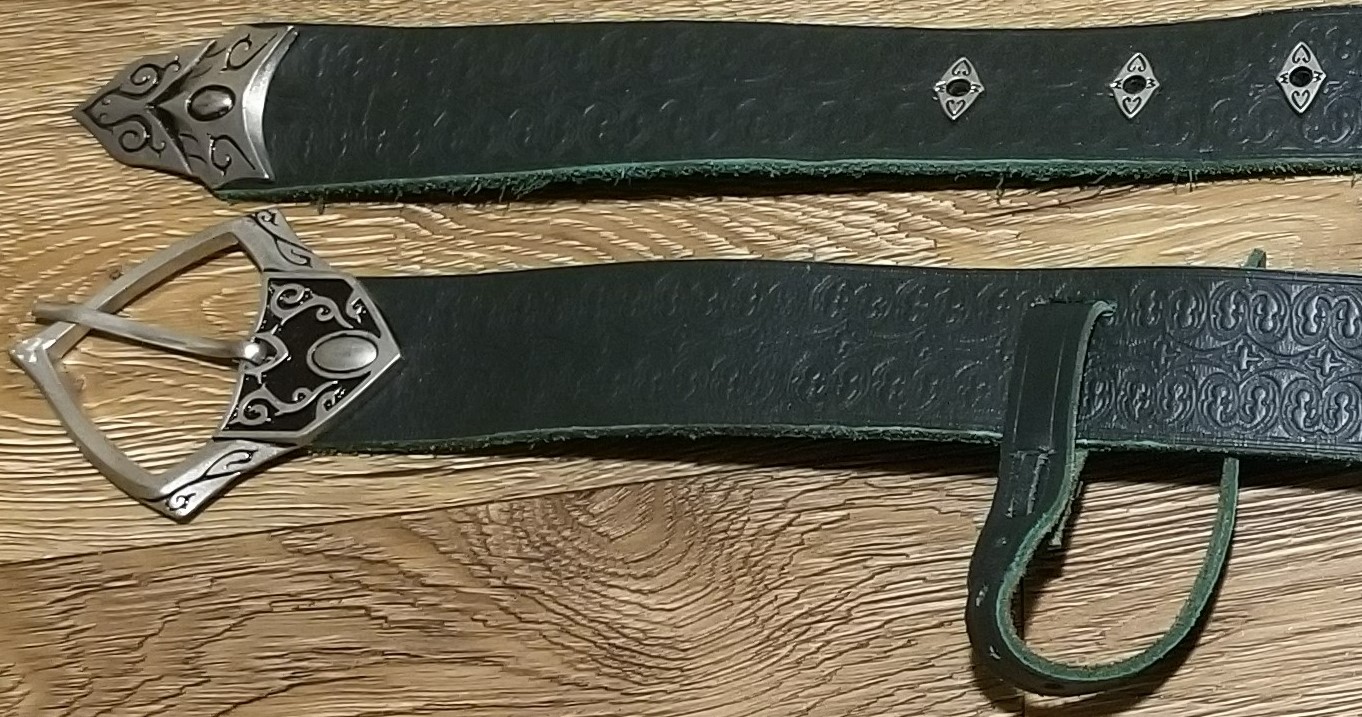
The leather straps that buckle the sword to the belt are integrated into the belt itself. The connection between the straps and the belt is created by a hole cut in the belt for each strap. Then the straps are fed through and a piece of leather cord is used to tie the ends together. They are only supported by knots in the leather cords, but the looped cords create a very tight connection and will not easily come undone. I don’t foresee these giving out anytime in the near or distant future. That being said, they can be undone and reattached after some work, which is nice if you want to use the belt for a costume but leave the sword behind. This belt has a lot of potential to be versatile, and not just limited to being a sword belt.
The belt shares similar tooled designs to parts of the scabbard, except that the belt’s designs are those of trees rather than vines. Each of the belt holes has its own embossing, and the holes run along a significant length of the belt. The embossed belt buckle is gorgeous, as is the very end of the belt’s tongue, and completes the fantasy look. It’s a different overall design than Darksword’s normal belt offer, and one I hope to see on Darksword blades – particularly their fantasy blades – in the future.
I only have three criticisms about the belt itself: its length, its leather quality, and the straps holding the sword. It’s a bit difficult for me to wear properly due to its length. I can wear it if I cinch the belt down all the way to the last hole and loop the end of the belt through itself, but it leaves a long tail that can tangle in your legs while walking (unless the buckle is offset to your right slightly, but then it doesn’t look right). I also am not fond of the interior part of the belt, where the leather feels very coarse and rough. This part of the belt makes the leather very stiff, and consequently difficult to manipulate so I can attach the sword to the belt, and even just to buckle the belt. Although regular cleaning with Saddlesoap has helped loosen the belt up, and it has softened the leather some. I suspect that my earlier hypothesis about the leather drying out is correct; the leather just needs proper care, and it will slowly restore itself and become more flexible with more time.
The third criticism is merely a quality control issue, although I don’t know if this is unique to my sword belt or a common problem. The straps connected to the belt themselves were swapped into the wrong holes, so the shorter strap (meant for the throat of the scabbard) was in the back, and the longer strap (meant for the main part of the scabbard) was in the front. Someone must have messed up during belt assembly – big oops! I’m ashamed to admit I was so excited by the sword itself I didn’t notice until I tried to put the belt and sword on, and couldn’t figure out why it didn’t hang right. Once I identified the swapped straps as the issue, I was able to rectify it in about 30 minutes by untying the straps from the belt and then retying them to their proper holes. Now the scabbard and sword wear correctly on the hip.
Handling Characteristics
This sword is heavy, and requires two hands to use.
Someone who is taller and stronger can handle it with only one hand, as
my friend Mitch did when I showed him the sword and let him handle it,
but in general it is heavy and might be too much for people of smaller
stature.
I tried various longsword attacks with this sword, and while
it moves sluggishly in the hand, once it actually picks up a little
momentum it GOES! When I practiced thrusting with it, the blade picked
up some significant forward momentum on its own, and practically flew
across the room of its own accord, dragging me with it. Good thing I was
up against one wall when I started the thrust!
When I perform a mandritto fendente (downward swing from the right to the left), the sword responds particularly well to proper footwork. To perform the maneuver, I must step only once the blade is fully extended, about halfway through the cut where it (ideally) meets the target. When I do this properly, the sword “leans” into the attack, and the second half of the cut becomes devastatingly powerful and far easier to control. If I get lazy with my footwork, and step before the proper time, or wait too long, the blade gets unwieldy. Proper arm positioning and transitions between guards is also essential to controlling a blade this big and heavy – no shortcuts in form are allowed with this sword!
A note on handling and training: if you are not trained in a sword martial art, or do not have a basic grasp of the basic forms, you may find this sword very difficult to handle. It demands proper form to wield correctly, and if you get lazy (which is very easy to do) it punishes you. That being said, it is still difficult to use in proper form, mostly because of the weight. But that is something that can be mitigated through training and familiarity. I’ve played with the sword since June 27th, training with it in various forms, and I find that each time I handle it, the sword becomes more responsive and less unwieldly. Not only am I slowly getting stronger, but I’ve also noticed an improvement in my technique and form as a result of training with this blade.
Hint: the
secret to wielding this sword, regardless of training, is to feel it,
not command it. The difference is very, very subtle, but it has a huge
impact on the sword’s handling abilities. You have to be willing to
commit to a specific cut, and then let it do its thing and adjust to
absorb the torque and momentum. In other words, you have to think of
your hands and arms as guiding the sword, but not controlling its
movements. This sword handles really well when left to (mostly) its own
devices. I might sound as though I speak of the sword as a living,
sentient object, but this is really just basic psychology. If I think of
it as a tool, I tend to try to micromanage the sword’s every move, and
tense up. This will always, as a rule, throw off balance and interfere
with the cut and thrust motions. But if I think of it as an extension of
my arm or as a living thing, then I relax and stop overthinking each
action, letting it flow naturally. The sword responds positively to this
kind of handling.
Test Cutiing
The first test was the good old fashioned paper slice. I’ve heard complaints that Darksword does not put a good edge on the blade, and that a lot of their blades aren’t sharp enough to pass this test, so I decided to try it for myself. The factory edge cut the paper, but it was more of a shear than a cut and wasn’t super clean (right cut on picture below). I opted to strop one edge against a leather belt to refine it, just for kicks, and tried the cut again. The paper cut much cleaner, although it was still not a perfectly clean cut (left cut on picture below)
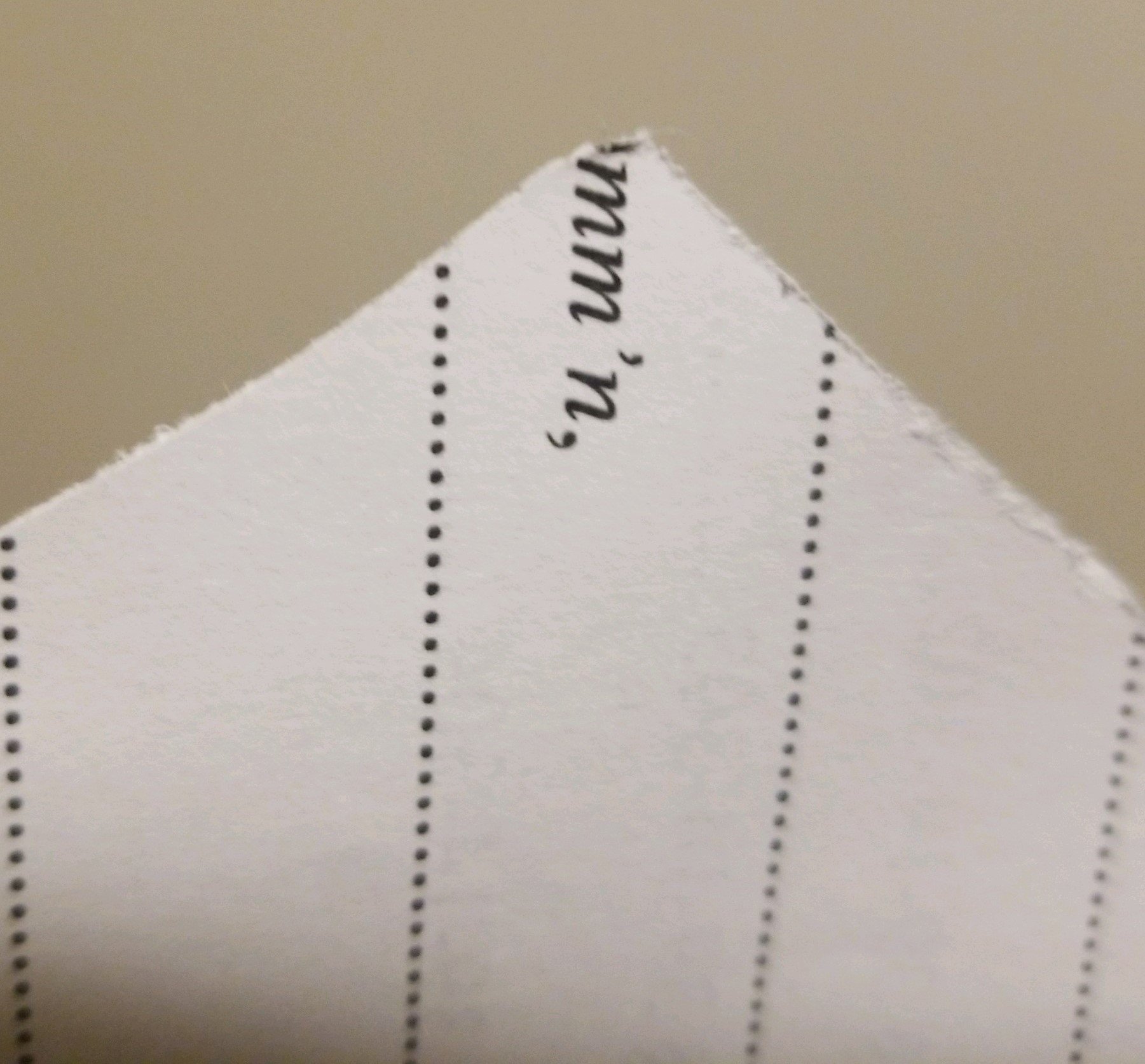 Not bad, could be better
Not bad, could be betterThis sword is a powerful cutter and thruster, capable of devastating blows. It will puncture cardboard with no resistance on a thrust. I cringe when I imagine what it would do to my special padded fencing armor. Fencing foils, epees, and sabers can’t pierce it (unless they were to somehow break mid-thrust), but I have no doubt the Vindaaris would render all that protective equipment useless in a second. That isn’t even the scariest aspect of this sword’s thrusting capabilities. When punching through cardboard, it can bite so deep from its momentum that the blade runs up against the unsharpened diamond-flare, which in turn splits open the puncture even more.
The weight and balance of the sword, combined with its tendency to pick up momentum, is an asset to cutting. Its no-nonsense attitude towards cutting also helps keep the edge aligned properly to the intended target, so that the cut will be clean. It halved this honeydew in half twice with no issues. I didn’t even feel it make contact with the melon; I just heard a ring of steel, and then a plop as the top half of the melon fell off the stand. I used the factory edge once, and the stropped edge once, for these cuts. Both were very clean and effortless.
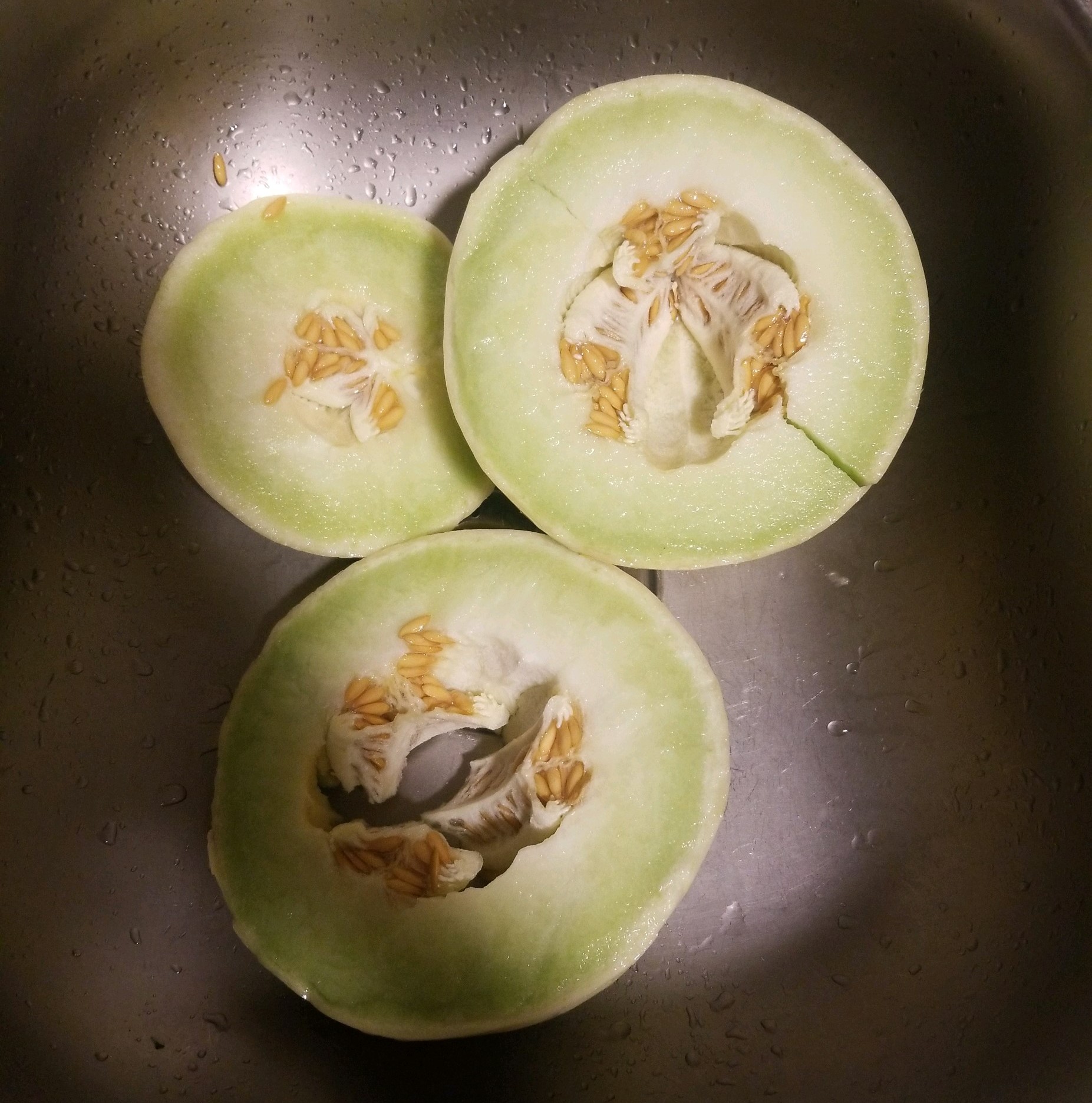 Most fun way to make fruit salads EVER
Most fun way to make fruit salads EVERThe sword fared worse with cutting water bottles. It is not sharp enough to actually slice the water bottles, even after I stropped it, and launched all of its half-dozen targets across the yard without actually cutting them. All I ended up with were dents in the plastic, and only a handful of actual tears and one cut (although I only achieved the latter by hitting the same spot on the bottles multiple times until it weakened to the point of tearing, as evidence by the damage in the pictures below).
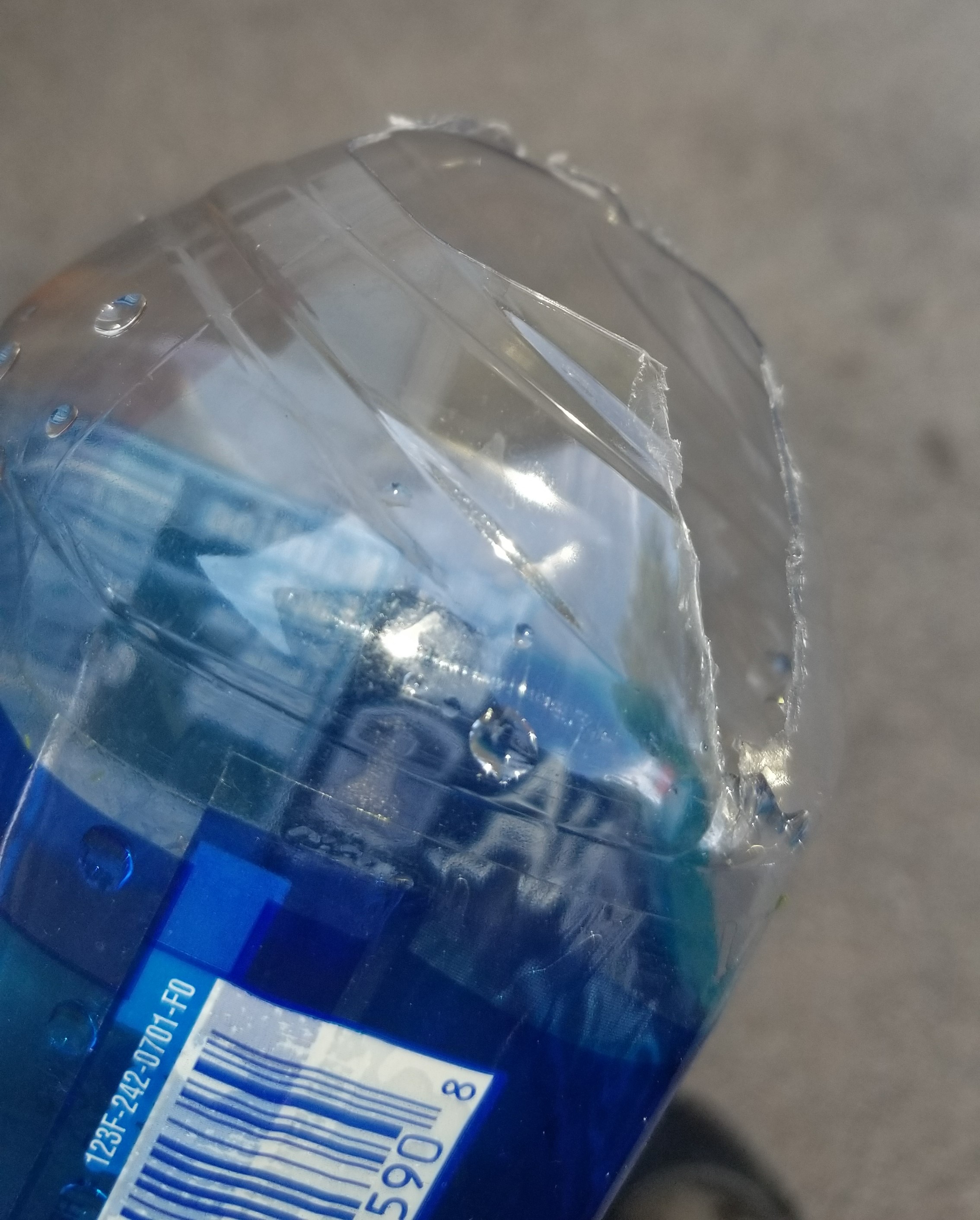

Giving due regard to this sword’s massive weight and size (for me), as well as the high probability that my own cutting techniques were responsible for the abysmal performance in water bottle cutting, I asked Mitch, who has more experience and much better technique, to test the blade’s cutting abilities. On the water bottles, he had a little more success than I did, but the plastic of the bottles still tore rather than cut. In the end, we both concluded that the abysmal cutting performance was less user error, and more that the edge of the Vindaaris was not sharp enough for a plastic target like water bottles.
More concerning was the slight loosening of the guard after testing the sword against the water bottles. It’s almost imperceptible to the eye, but it can be felt in the hands, and certainly did not exist before. It raises questions about the durability of this particular sword’s construction, but Darksword has addressed and resolved that concern. (See Customer Service section below)
Customer Service
The defects in the bent tip and loose guard are good places to discuss Darksword Armory’s customer service. After the tip bent for the second time, I emailed Darksword about the bent tip and the loose guard. They responded to me within 24 hours, and took the sword back in accordance with their warranty policy, which means they paid for the shipping costs, sent me the shipping label, and repaired the sword at no charge. They fixed the loose guard under warranty, and now it’s nice and tight again. Although I did have an outside smith repair that bent tip the first time, Darksword kindly repaired it for me, and the repair job so far has held up nicely. I am grateful to them for going the extra mile regarding the sword, because they didn’t have any legal obligation under warranty to repair the bent tip after I had another smith repair it first; their only warranty obligation was to the loose guard by that point.
Conclusion

This sword would make a fine addition to any collection, particularly those with a fantasy theme. It incorporates enough design features from multiple fantasy settings to easily merge into any of them. It fits in with Lord of the Rings weapons, and it also would look at home beside Heimdall’s sword from the Marvel Cinematic Universe, Tyr’s sword from Norse mythology, or the Rider’s swords from Eragon. It also makes a plausible holy avenger replica sword for the D&D fan.
The Vindaaris also has the versatility to be a beautiful wallhanger, a functional cut and thrust weapon, or both. The belt and scabbard design allows a large amount of variability in the carry angle, and adjusts easily to the height of the person wearing it.
On its own, the Vindaaris would not likely make a good sword for the person who likes the occasional, recreational backyard cutting. If you aren’t trained in basic sword forms and just swing swords around without regard to the old fighting techniques, this blade could easily become a nightmare to wield. In short, if you’re not serious about training with it or taking the time to learn proper technique for your backyard cutting, then it might not be that much fun to use. If you are strong enough or practiced enough, however, to swing a sword of this size and weight around, then the weight and handling will likely not pose a problem.
As a training sword, however, it has enormous potential. The way it rewards good form and punishes bad form, in addition to the muscle build-up from training with a heavier blade, makes it a great teaching blade for the old longsword fighting techniques. If you were to train with this sword, and then use a lighter sword, you will find that lighter sword a pleasure to use. If you love backyard cutting, training with this sword will teach you the proper technique to deliver satisfying blows to cutting targets, and it makes cutting targets with other swords more fun. And with the right techniques and enough acclimation to its size and weight, it also has the potential to make a terrific cutting and thrusting blade itself.
In regard to my experience with the sharpening service (both on this sword and the Mother of Dragons sword I ordered at the same time), the only real benefit is the creation of an edge. The sharpening was not good enough on my Vindaaris to cut through water bottles, although it is effective against melons, and I don’t doubt it’s sharp enough to do damage to the hypothetical living target (in other words, still be careful!). If you don’t like sharpening a sword from scratch, or don’t have the experience, ordering the sharpening service does help create a predefined edge that you can further sharpen to your own preferences.
PROS
- The attention to detail on scabbard and guard is beautiful.
- The engravings on both guard and blade are very clean and beautifully etched.
- The sword looks unique, and fits into any number of different fantasy worlds.
- This blade has some serious power behind its cuts and thrusts.
- This sword lends itself particularly well to martial arts training, and is a good teaching sword that rewards good technique and punishes the bad or lazy, thereby ensuring technique is learned properly. If you don’t have a proper sword-master, this sword is more than sufficient to teach you the basics. It also is an excellent sword to learn proper cutting technique with, on account of its size and weight.
- Quick and excellent customer service in repairing the loose guard and bent tip.
CONS
- The weight of the sword may be too heavy for people with less developed upper body strength.
- The length of the sword may be too long for shorter people to wield.
- The grip doesn’t match up with pommel in circumference, leaving a noticeable ridge. Same for the ring bisecting the grip, which is also not secure.
- The tip of the sword arrived slightly bent, and the guard loosened slightly after hacking on several water bottles.
- The throat of scabbard doesn’t fit properly with the sword.
- This sword favors a trained martial artist and works better as a teaching blade than a recreational blade for cutting.
- The edge was not sharp enough for water bottle cutting.
THE BOTTOM LINE
So here’s the big question: would I recommend this sword?
My answer is: it depends on what you want it for.
The Vindaaris has a relatively solid construction and makes a decent marriage of form and function, particularly for a fantasy blade. It is on the heavier side, true, but it will handle well for anyone who takes the time to train and practice with it. Once the effort is put in, then its power and ability to deliver devastating cuts and thrusts shines through. I am confident it will become a satisfying recreational cutter once I get a better edge on the blade and train more with it. But there are cheaper training swords available on other websites, so it’s not necessarily a good value for a simple training sword.
The fantasy details on the scabbard, blade, and guard make this weapon a beauty to behold. It makes a good display piece as well as a functional piece, so if you are not into wielding your swords in imaginary combat (like orcs) or cutting apart fruit and plastic bottles, you can still enjoy it. It would make a great addition to a fantasy themed event.
It’s a bit expensive for a 'wallhanger' (Editors note: as it is is technically battle ready, it's can't be called wallhanger), but if this is a design that appeals to you, then you might consider the money well spent. If you want a sword that is a decorative wallhanger, a functional cutter, and training sword, and you have the budget, then this sword may be worth the price for you.
In terms of quality, however, this sword is not quite worth its price. It’s an expensive piece, approaching Albion’s lower range of prices. Some of the fit and finish was not as clean as might be expected for a sword ranging between $715-840 depending on scabbard and sharpening choices. The major design issues were the ring bisecting the handle not being tight, and the guard digging into the hand with gripping and handling the sword. The integrity issues were addressed and repaired to my satisfaction by Darksword Armory.
If you are interested in visiting the sword's sale page, below is the link here for your convenience.
WHERE TO BUY
You can pick up the Vindaaris at Darksword-Armory.com, HERE at Kult of Athena and even get it with free shipping and extended warranty HERE at the official SBG Sword Store, so definitely a little spoiled for choices.
I hope you enjoyed the Vindaaris Review. To return to Decorative and Functional Fantasy Swords from the Vindaaris Review, click here



